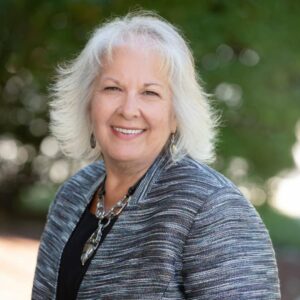Culture change drives CHOICES
Photo by Rick Friedman Server Amy Laroche presents a tray of tempting delicacies to Villa Crest residents. |
Sarah McEvoy talks about the four daughters who showed up like clockwork every Monday around mealtime to visit their 98-year-old mother, a resident at Villa Crest Nursing and Retirement Center. “We didn’t have a comfortable place to accommodate them,” says McEvoy, the high-spirited administrator of the nonprofit community for the past 14 years. The main dining room was nicely appointed with linen tablecloths and fresh flowers, but seating only accommodated 64 of the 155 residents and offered no space for guests.
Space was only one nagging issue related to the dining experience just two years ago. Residents chose from a four-item menu but had to make their lunch selections at the breakfast meal and their dinner selections at the lunch meal. The dining program featured a mass-produced, steam table approach to serving large numbers of residents in a short period of time. It lacked a fresh, made-to-order taste.
Residents entered the dining room promptly at noon and 5 p.m. and one server brought the meals out as quickly as possible. Beverages were pre-poured and passed once residents took their assigned seats. Although the starting table changed each day, the unfortunate residents who were served last waited up to 30 minutes to eat. Residents were limited to set mealtimes with little flexibility for late sleepers or early risers, daytime doctor appointments or afternoon beauty salon visits.
Residents who came to the center for short-term rehabilitation were restricted to room service because of the limited seating capacity and the fact that long-term residents sat in the same seats at each meal, leaving no space for new residents.
Still, “this is a really special place,” says McEvoy. “We have a beautiful blend of residents who are very independent and those who are very dependent. It’s an integration that just works really well.”
Villa Crest’s team (from left to right-front to back): Richard Vachon, cook; Janelle Pizarro, waitress; Steve Wingate, cook; Amy Laroche, waitress; Joe Gifford, cook; Cassie Peterson, waitress; Susan Lievens, recreation director/hostess; Kaitlyn Mercier, waitress; Paul Silkman, diet aide; Manny Perry, food service supervisor; Sheila Letendre, diet aide, Holly VanLaarHoven, recreation assistant/hostess; Kathy O’Hara, RD; Seth Sawyer, diet aide; Alyssa Sawyer, waitress; Dan Wheller, cook/waiter; Tameson O’Brien, recreation assistant. |
DEFINING CHANGE
Community management became convinced of the need for change after attending a culture change conference and touring several communities active in the movement. “Visiting those other centers showed us that there are different ways to make our center a home and make it more resident-centered. We returned thinking we can do so much more and do it so much better,” says McEvoy.
OPTIMA AwardSince 1996, Long-Term Living has honored long-term care communities that are proactive with programs that go “above and beyond” routine care for their residents with our prestigious OPTIMA Award. It is conferred by a jury of your long-term care peers from submitted entries. This year’s winner is Villa Crest Nursing and Retirement Center of Manchester, N.H. A trip by managers to a culture change conference followed by a tour of communities active in the culture change movement convinced the partners that change was imperative in their own community. They were exposed to dining options that met the need for resident choice, flexibility, socialization and satisfaction. A survey of community stakeholders led to the formation of CHOICES Restaurant in 2010. Specialized staff training taught servers how to blend hospitality with proper serving techniques. A new menu with a wide variety of meal choices, extended service hours and attentive staff resulted in a resident-centered approach to mealtimes. Other benefits included a place for families to visit and dine with loved ones, satisfied residents and improved resident weight outcomes. Our congratulations to this year’s winner for all the hard work, inspired ideas and commitment to making a positive change every day in every elder’s life. |
Not long after that, Manny Perry-the equally high-spirited food service supervisor and executive chef-said he wanted to do things differently at Villa Crest. “His approach is, ‘Let’s give it a whirl and see what happens,’” McEvoy says, “whereas I’m more like, ‘Let’s plan it down to every detail.’ We landed somewhere in the middle, which worked for us.”
“The road trip really opened my eyes,” says Perry. “We had some phases to go through. I wanted to eliminate food truck deliveries to the floors and build mini-kitchens. That’s still in progress.”
To determine the scope of the dining service problem and define the direction of change, the partners consulted with residents and families and the culinary experts on staff. A survey was created for residents, family members and other guests. Questions included:
What were meals like in your home?
What types of food did you/do you enjoy?
What time do you want to dine?
With whom would you like to dine?
The goal was to increase food service customer satisfaction scores to 9.1 or above on a 10-point scale through dining services that offered greater flexibility, more opportunity for socialization and increased choice.
The planning of CHOICES Restaurant occurred on several levels. The first priority was to introduce the culture change concept to all partners and gain their support of the need to change. This occurred through the use of a series of culture change training modules.
The second level of planning incorporated brainstorming sessions with stakeholders throughout the center. These stakeholders became a permanent dining committee that tackled tough questions like:
How do we leverage our current strength in dining service?
What enhancements fit our current physical plant structure?
Is there enough space in the kitchen to pursue short order service while maintaining a room service tray line?
What equipment is required to add short order capabilities to the current tray line service?
Will extra staff be needed?
How will we support the residents through the change?
How will residents be involved in the process?
What is the best way to communicate changes to partners, residents and families?
Villa Crest Administrator Sarah McEvoy |
STEP BY STEP
Once the decision was made to create a full-service restaurant, Perry and the cooking staff evaluated kitchen space and equipment and processes. The dietician and dining committee worked with residents on the menu options and preferred hours of restaurant operation. The administrator in training and Perry began to look at staffing, scheduling and job descriptions.
It became clear early in the process that several steps were dependent on other steps. For example, the types of food the residents desired would determine the need for specific equipment. The food item residents requested most was French fries. They talked about missing the taste of piping hot fries, onion rings and crispy chicken tenders. Obviously, a deep fryer would be necessary. Residents also desired lighter meal options such as freshly made soups, salads and sandwiches. These choices drove the addition of a refrigerated holding unit.
“The fryer has been a huge success,” relates Perry. “We always had baked fries and the tips would get rock hard. The deep fryer retains the heat in the fries really well. We’ve got the shoestrings, the steak fries-we even have fried pickles.”
Once the residents got a taste of the new fare, they started requesting more adventurous culinary offerings including a variety of pasta bowls, regional specialties like salmon pie and even lobster mac’n cheese.
In the dining room, cloth awnings imprinted with the name of the restaurant were installed over the entry doors to create the look and feel of a restaurant. Tables were divided into four sections that were identified using a color-coded numbering system, which corresponded to the server assigned to that section.
Just as the type of food determined the necessary equipment, the level of service and hours of operation drove staffing requirements. The residents were already enjoying a continental breakfast with made-to-order eggs between 7:30 and 9 a.m. The dining committee provided feedback that the residents would also like expanded hours for the other two meals.
Photo by Rick Friedman Food service supervisor Manny Perry and his team at work in the redesigned kitchen |
Perry had to design a new staffing pattern to accommodate the expanded hours and greater number of diners. A short order cook and three servers were added. The labor hours for the short order cook were created from hours being used for a prep cook. Some of the labor hours needed to add the part-time servers came from the decrease in hours necessary to prepare room service trays.
There were some increased labor costs, reports McEvoy. “However, we have seen an explosion in food sales because of the opportunity for family members to dine with their loved one. We’ll probably make $30,000 in food sales this year simply from family members dining,” she says.
CHALLENGES AND OUTCOMES
Kind DiningIn preparation for implementation of the CHOICES program, Villa Crest initiated a plan for training staff in restaurant-style service skills. A seminar called “Kind Dining: Bringing Warmth to the Table” was brought in house. The instructor presented a three-day, 12-hour training session. The program was designed to teach servers how to blend hospitality with proper serving techniques. The syllabus included nine modules: Making a House a Home, Feel the Change a Comin’, What YOU Bring to the Table, Setting the Meal, Symphony of Service, If I Only Had a Heart, Emotion Control, Don’t Touch That! and Polishing Service. Two fundamental concepts of Kind Dining helped to focus partners on the goal of improving resident-centered meal service. The first concept, based on the finding that many residents spend over 60 percent of their normal day around meals, helped partners to think about the resident’s day, why residents look forward to meals and how important mealtime is from the resident’s perspective. The second concept focused on research that showed that residents who were highly satisfied with food, meals and the dining experience were more satisfied overall (see table above). Partners were empowered with the knowledge that their efforts to improve the dining experience would improve the overall well-being of the residents. Among the 60 partners who completed the Kind Dining training were managers, social workers, nursing assistants and licensed nurses. “There were people who went through the program thinking, ‘How do I fit in the dining environment?’ and there was some hesitation at first,” says McEvoy. “‘I’m a nurse, not a waitress.’ But we’re all about everything for the resident. You may be trained to be a nurse but right now we’re doing dining. It’s a change for everyone.” For more information on the Kind Dining program, visit www.higherstandards.org/kind-dining-training. |
When CHOICES opened on April 1, 2010, it soon became apparent that several concepts needed to be changed or improved. Because response to the restaurant was overwhelming, the decision was made to add two hostesses during the peak hours of operation. Partners from every department were trained to work as hostesses.
“We’ve made mistakes along the way,” says McEvoy. “For example, we started out with all the menus having prices and residents would say ‘I have to pay for my meal now?’ We also started out requiring families to make reservations but that was silly-they’re here and should be able to go for the meal.”
And the positives? “It’s amazing to me that when you de-institutionalize things it changes everything,” says McEvoy. “The difference between people going in and sitting where they always sit every day and people waiting for the hostess to seat them and they are introduced to other people … we’ve had people meet others who grew up together on the same street. The level of conversation has grown tremendously. And it’s forced all staff to know everyone’s name because they have to introduce people.”
The expanded hours and greater seating capacity make it easier for short-term residents to spend time out of their rooms. This has proven popular with residents’ spouses who are able to eat with the resident in a restaurant setting instead of dining alone at home or hovering over a tray table in a semi-private room. McEvoy says spouses have reported that they probably wouldn’t be eating otherwise as it’s usually a stressful time while their husband or wife is recovering.
Staff benefited, too, from the changes. “The energy in the kitchen is amazing,” says Perry. “We’ve got a younger crew here and they’re so excited. They’re actually waiting tables! Residents want to talk to them and they ask, ‘Is so and so working tonight?’
“Before, you could go in that dining room and hear a pin drop,” continues Perry. “It was just going through the motions. Now you have to yell across the room [to be heard]. It’s that active. Plus, the residents’ minds are stimulated. They have more opportunity to pick and choose their meals.”
What about the four daughters and their weekly visits to their 98-year-old mother? “Now they can be with their mom for meals,” says McEvoy, with pride in her voice. “I’ve often hostessed in the dining room on Monday evenings and I’d see them and it was so fun. Then the daughters started bringing their daughters in and it became even more of a family thing-an opportunity to get together like they would if they were at home.”
Long-Term Living 2011 September;60(9):34-41

Patricia Sheehan was Editor in Chief of I Advance Senior Care / Long Term Living from 2010-2013. She is now manager, communications at Nestlé USA.
Related Articles
Topics: Articles , Leadership , Nutrition , Operations












